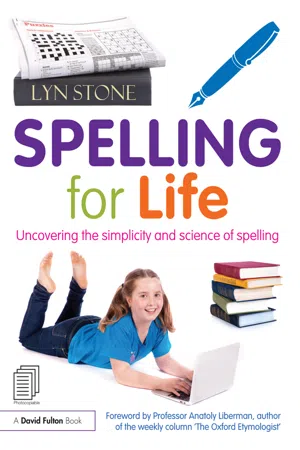
- 280 pages
- English
- ePUB (mobile friendly)
- Available on iOS & Android
About this book
A recent survey of 200 teachers asking the question 'spelling is…?' resulted in the following adjectives: 'difficult', 'complex', 'confusing', 'random', 'confounding'. Spelling for Life offers lucid, accessible tools which help to reveal that, when explicitly and systematically taught, spelling is scientific, law-abiding and even elegant.
It explains that spelling is the manipulation of symbols according to agreed-upon patterns that produce predictable results. Spelling errors also fall into sets of predictable patterns. Success in spelling is not a product of intelligence. Many people struggle to spell due to coping strategies developed in place of explicit instruction. What gives spelling its 'complex' veneer is the fact that different ways of thinking are required at different levels from word to word. Some words can be spelt as they sound, others have to be visually memorised and some rely on knowledge of core rules about word-structure. A lot of words require more than one strand of knowledge. This book makes clear which strand needs to be applied in different situations.
Often pupils who can read and express themselves competently nevertheless find spelling difficult. False assumptions about spelling, such as believing the English language is complex and/or irregular, damage confidence and lead to reluctance to even attempt to spell correctly.
Spelling For Life enables teachers andpupils to:
- learn what the common spelling coping strategies are
-
- gain insights into undoing poor spelling habits
-
- work together to notice patterns not only in regular spelling, but also in words which on the surface seem to break the spelling rules
-
- practise successful spelling strategies, progressing from simple to complex words rapidly and with confidence.
-
Using a synthesis of theory, research and teaching experience, the fascinating nature of English spelling is systematically teased out. The examples and exercises offer an encouraging, accessible way to implement the programme of study and strive to reveal the beauty of spelling. Aided by example lessons, progressive assessments, unique tools and extensive practice lists, this highly acclaimed overview of spelling succeeds in developing critical thinking and confidence when reading and spelling. It can be used in conjunction with any established phonics programme.
Frequently asked questions
- Essential is ideal for learners and professionals who enjoy exploring a wide range of subjects. Access the Essential Library with 800,000+ trusted titles and best-sellers across business, personal growth, and the humanities. Includes unlimited reading time and Standard Read Aloud voice.
- Complete: Perfect for advanced learners and researchers needing full, unrestricted access. Unlock 1.4M+ books across hundreds of subjects, including academic and specialized titles. The Complete Plan also includes advanced features like Premium Read Aloud and Research Assistant.
Please note we cannot support devices running on iOS 13 and Android 7 or earlier. Learn more about using the app.
Information
1
Broken rules and word stories
Exceptions
- notice which rule applies or is broken
- investigate the reason for the perceived break, i.e. the word story
- assign the words to groups that share common characteristics, what we will call word families.
- Borrowed words – as we move toward globalisation, words from other languages continue to swell our lexicon (‘spaghetti’, ‘ski’, ‘haiku’).
- Abbreviations – words which, when shortened, break conventional spelling rules (‘rev’ from ‘revolution’, ‘taxi’ from ‘taxicab’, ‘mini’ from ‘miniature’).
- Acronyms – words made from the first letter or letters of other words (‘Qantas’, ‘lol’ etc.).
- Names – place names often break the core rules because they belong to other languages with other sets of rules (‘Iraq’, ‘Benghazi’). Human names often don’t conform because they are created through a process of parental invention rather than linguistic evolution (‘Dannii’, ‘Keanu’).
- Jargon – technical/scientific vocabulary (‘radii’, ‘caesarean’, ‘schwa’).
- Old and/or common – words that are obeying rules from times past, whose spelling hasn’t caught up with the way we say them (‘horse’, ‘have’, ‘could’, ‘of’).
- Slang – vocabulary used by a particular generation of younger speakers or groups (‘chav’, ‘wassup’, ‘ermahgerd’).
Lesson plan
Skill level
Materials
- Figure 1.1 Mouth picture
- Figure 1.2 Book picture
- Figure 1.3 Word stories example worksheet
- Figure 1.4 Word stories blank worksheet.



Pattern
Error pattern
Duration
Step 1

Step 2
Step 3
Example lesson
Table of contents
- Cover
- Title
- Copyright
- Dedication
- Contents
- Foreword
- Preface
- Acknowledgements
- Sound to symbol notation
- Introduction
- 1 Broken rules and word stories
- 2 Word families
- 3 Homophones
- 4 Mnemonics
- 5 Counting syllables
- 6 Affixes
- 7 The Spelling Formula
- 8 The difference between vowels and consonants
- 9 What consonants say
- 10 Illegal Letters
- 11 The single vowels
- 12 The letter ‘y’
- 13 Final Silent E, Jobs 1–3
- 14 Final Silent E, Job 4 (a.k.a. ‘consonant plus -le’)
- 15 The Wicked Sisters and other Wacky R’s
- 16 The Vowel Generator
- 17 Strong and weak syllables
- 18 Schwa
- 19 To double or not to double?
- 20 Final Silent E and suffixes
- 21 The return of Illegal ‘i’
- 22 The Suffix Generator
- 23 More fascinating patterns
- 24 Some delightful lists
- Appendix 1 Forgive me, Scotland
- Appendix 2 The orders of intelligence
- Appendix 3 The Triangle Game
- Appendix 4 Why not just make spelling simpler?
- Glossary
- Bibliography
- Index